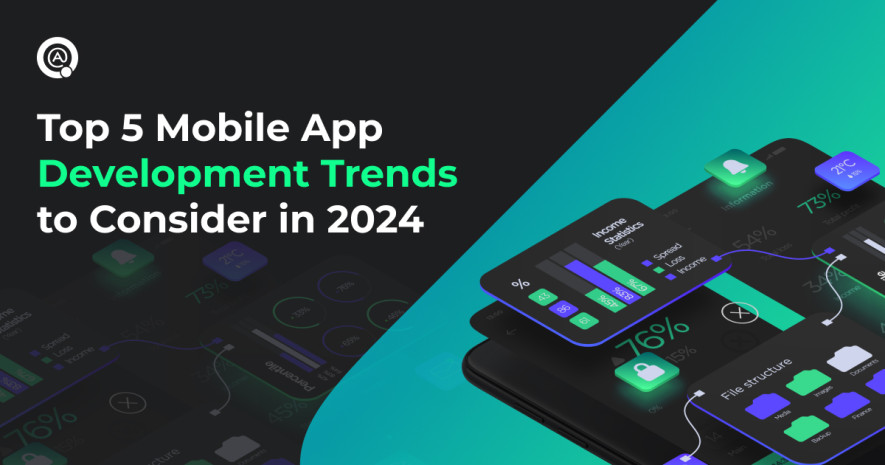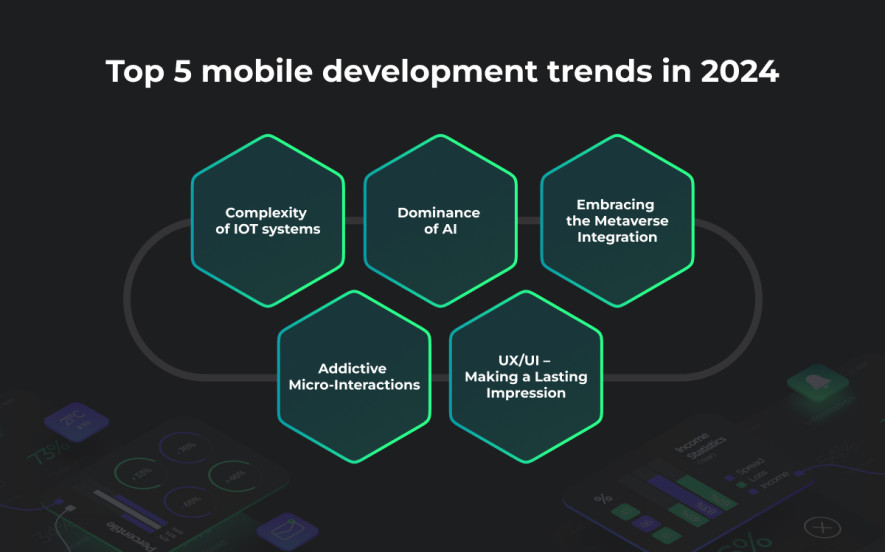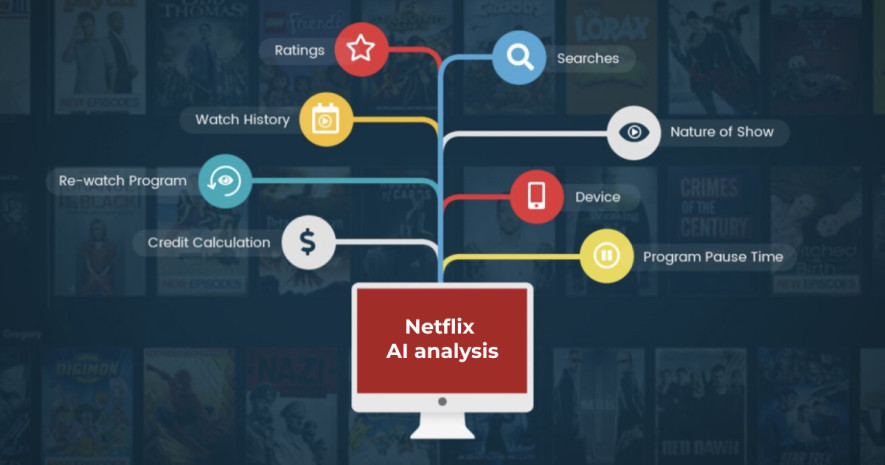- QATestLab Blog >
- Mobile Testing >
- Top 5 Mobile App Development Trends to Consider in 2024
Top 5 Mobile App Development Trends to Consider in 2024

The relentless pace of technological advancement showers us with unseen innovations, particularly in the realm of mobile apps and devices. Today, smartphones, tablets, and smartwatches have become indispensable companions, seamlessly integrated into our daily routines. From checking emails and setting alarms to organizing schedules, consuming media, and even managing health, these mobile enhancements simplify our lives in countless ways.
Such omnipresence has driven mobile apps to the forefront of modern technology. Statistics reveal that nearly 6,1 billion people use mobile devices, which is 75% of the global population, dedicating an average of 5 hours daily to app engagement. The convenience and problem-solving potential of mobile phones were the key conditions for such a widespread mobile app development.
However, in this dynamic landscape, new challenges emerge, pushing developers to elevate the mobile app experience to extraordinary heights. Let’s delve into five key challenges of 2024 and explore how overcoming them benefits your business and development team.

1. Dominance of AI
Artificial intelligence (AI) exploded onto the scene in 2023, with ChatGPT’s meteoric rise exemplifying its immense potential. This chat-based AI surpassed 100 million monthly users in just two months, a feat that took Instagram 2.5 years and TikTok nine months to achieve. No wonder, there is a growing buzz around AI and its relevance to mobile app development.
In 2024, AI and machine learning (ML) will go beyond mere convenience in mobile apps. They will revolutionize the user experience by creating applications that truly understand users. Imagine apps that anticipate your needs, personalize content like a trusted friend, and adapt to your evolving preferences – this is the promise of AI and ML. Tech giants like Netflix and Spotify have partially gained global recognition thanks to artificial intelligence technologies.
Netflix’s popularity, in part, stems from its AI algorithms that identify your potential viewing preferences. Based on your watch history and other factors, the platform curates a personalized queue, effectively predicting what you will enjoy next. This level of user understanding and interaction is what AI brings to the table.

While AI unlocks incredible possibilities, it also throws down the gauntlet with unique challenges. What is the biggest hurdle, you may ask? It is simple – a limited pool of specialists equipped to handle the complexities of AI troubleshooting. This field makes it tough to find experts who can truly refine and optimize AI products for peak performance.
Adding to the puzzle is the intricate ballet of AI quality assurance. Predicting and testing the vast spectrum of scenarios an AI might encounter can feel like chasing a shooting star. We have already witnessed cases where AI malfunctions raised ethical concerns, highlighting the critical need for meticulous testing and swift reporting of any potential misbehavior. While AI unlocks incredible possibilities, its complexities can be daunting. If you are working on a software product with an AI component, let us know, and we will be eager to explore the most optimal QA solutions for it.
2. Complexity of IOT systems
The Internet of Things (IoT) is woven into the fabric of the future, reshaping how we interact with the world around us. It is not just about smart homes with automated blinds and pre-heated ovens; it is about creating intricate networks that connect devices, applications, and entire ecosystems. Smart factories optimize production, connected cities enhance sustainability, and healthcare embraces remote monitoring – the possibilities are endless.
Take the Tesla app, for instance. You can monitor your car’s battery health, schedule charging, or even summon it to your parking lot – all from your smartphone. This level of sophistication, however, presents unique challenges for mobile app development.
- Connectivity Conundrum: Ensuring seamless communication between countless devices and mobile apps across diverse networks can be a complex puzzle. From unstable internet connections to compatibility issues, maintaining reliable interconnectivity requires robust testing and optimization strategies.
- Compatibility Chaos: The landscape of connected devices is a diverse one, with a multitude of operating systems and communication protocols. Developers must navigate this technical labyrinth, ensuring their apps seamlessly integrate with various hardware configurations. This task demands meticulous compatibility testing and a deep understanding of diverse IoT ecosystems.
- QA Quandary: The scarcity of specialists in the realm of IoT testing further amplifies the challenge. The intricate nature of these interconnected systems requires a unique skillset encompassing traditional mobile app testing expertise alongside specialized knowledge of network protocols, device configurations, and security considerations.
While these challenges are formidable, they also represent immense opportunities. Mastering the complexities of IoT will unlock a new era of intelligent applications that reshape industries and enrich our lives. By investing in robust testing infrastructure, fostering skilled QA teams, and using various real testing devices, you can navigate this dynamic terrain and unlock the full potential of the interconnected future.
3. Embracing the Metaverse Integration
The term “Metaverse” has ignited imaginations, conjuring visions of a parallel 3D reality powered by Augmented Reality (AR) and Virtual Reality (VR) technologies. This emerging domain holds the potential to redefine the way we interact with the world and offers the possibilities we could only read about before.
Imagine trying on clothes in a virtual shop while strolling through Singapore’s vibrant streets or even joining a virtual Mars expedition alongside real-time explorers. Education, too, stands to be revolutionized. Forget dry textbooks; imagine students immersed in VR classrooms, exploring the rings of Saturn alongside virtual pioneers.
However, this “unseen future” comes with its own set of challenges. One major hurdle is processing power. While mobile devices are constantly evolving, they still struggle with the demanding needs of VR and AR applications. Efficient rendering techniques and resource optimization are crucial to ensure a smooth and immersive experience.
Another challenge lies in device fragmentation. The vast array of mobile devices with varying specifications presents a compatibility nightmare. Developers must navigate this intricate landscape, making sure their apps function flawlessly across different screen sizes, operating systems, and hardware capabilities.Despite these hurdles, the potential of Metaverse integration remains undeniable. By investing in innovative hardware, optimizing for diverse devices, and fostering collaboration between developers and technology providers, we can pave the way for a future where mobile apps transcend the screen and transport us to the unimaginable.
4. UX/UI – Making a Lasting Impression
In the crowded world of mobile apps, first impressions matter. Just like a first date, the initial interaction – visual appeal, intuitiveness, and overall experience – can make or break user engagement. This is where the magic of UX/UI design comes in. It is the app’s first handshake, its smile, its witty opening line. The first impression determines whether users become loyal companions or swipe left in search of a better match.
A well-designed app transcends mere functionality. It is an extension of your brand identity, speaking through carefully chosen colors, fonts, and visuals that resonate with your audience. Consistency and memorability are key – think of the brand recognition evoked by Instagram’s vibrant layout or Spotify’s sleek interface.
But aesthetics alone are not enough. Users should not feel lost in a digital labyrinth. Good UX design is the map that guides them. Clear navigation, logical information architecture, and intuitive user flow ensure users find what they need effortlessly, reducing friction and boosting engagement. Compare it to the frustration of navigating an unclear app – it is like wandering through a maze without a map.
Therefore, rigorous UX/UI testing is a non-negotiable step for any successful app. In today’s fast-paced world, users will not tolerate clunky interfaces. Look at giants like Google Maps and TikTok – their success hinges on user-centric design. Maps provide unmatched clarity, with turn-by-turn navigation that is simple and reliable. TikTok keeps users hooked with its endless scroll of curated videos, intuitive editing tools, and interactive features, creating a personalized experience. Remember, UX/UI design is not just about ticking boxes; it is about crafting an emotional connection with users. By investing in thoughtful design, practicing meticulous testing, and learning from industry leaders, you can transform your app from a digital acquaintance into a beloved companion.
5. Addictive Micro-Interactions
Have you ever noticed the subtle feedback you receive when using your favorite apps? Like the satisfying click-clack sound of typing or the progress bar animating as you download a file? These seemingly insignificant details are micro-interactions, and they play a crucial role in shaping user experience.
Just like sound effects and facial expressions enhance a movie, micro-interactions breathe life into your mobile app. Progress bars with enticing animations, subtly changing app icons, and engaging transitions tell a story, making your app feel dynamic and alive.
Here are four key areas where micro-interactions can shine:
- Haptic feedback: Leveraging the power of vibration to create realistic and immersive experiences, like simulating button presses or mimicking the texture of virtual objects.
- AI-powered personalization: Tailoring micro-interactions to individual user preferences. Imagine receiving customized congratulations when completing a task or seeing app icons morphing based on your current mood.
- Augmented reality integration: Using AR elements to create engaging micro-interactions. Picture virtual confetti celebrating a milestone or interactive tutorials overlaid on real-world environments.
- Voice-driven feedback: Utilizing voice cues and responses to create a more natural and intuitive interaction. Imagine your app conversing with you, providing guidance or responding to your voice commands.
Remember, less is often more when it comes to micro-interactions. A gentle nudge, a flicker of color, a timely vibration – these subtle cues guide your users, making every interaction feel effortless and deeply personal. By incorporating these tiny signals into your app, you transform it from a functional tool into a captivating and memorable experience.
Embracing App Evolution: Leveraging Top Mobile Trends for Success
The mobile app landscape is in a constant state of fluctuation. As technologies advance, user expectations rise exponentially, demanding innovative solutions and immersive experiences. To stay ahead and attract users, developers must adapt and embrace the latest trends. While implementing all five trends simultaneously might not be achievable, understanding their interconnectivity and potential enhances your app’s appeal.
However, one significant challenge lies in the limited pool of professionals fluent in these new mobile development advancements. Mastering these complexities demands constant learning and adaptation, making it difficult to find specialists with the requisite expertise.
In today’s competitive mobile landscape, delivering a flawless app that meets user expectations requires comprehensive testing expertise. Here at QATestLab, we empower your team with highly skilled QA engineers, specializing in every level of complexity across diverse app development fields. Leverage the expertise of seasoned QA professionals to seamlessly integrate these cutting-edge trends, assuring top-notch quality control. Our dedicated specialists possess deep proficiency in testing for IoT apps, UX/UI design, AR/VR advancements, AI and Micro-Interaction testing.

If you’re seeking a swift and reliable solution to bolster your in-house team, look no further than QATestLab’s comprehensive mobile app testing services. Try seamless collaboration that eliminates the burden of recruiting and upskilling in-house testers on new technologies.
Learn more from QATestLab
Related Posts:
- Automation Testing for Mobile Apps: Why It’s Essential and Our Key Services
- How One Bug Can Wreck Your Reputation — And How QA Prevents It
- Testing on Real Devices — Just an Option or a Necessity?





